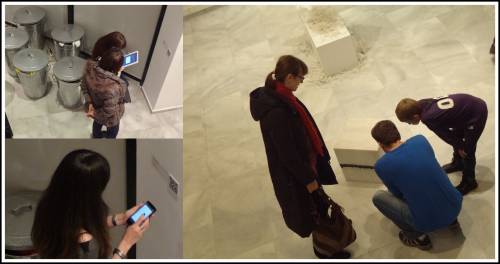Taggling
Tagging of an artwork can be part of a non-formal description of the artwork. In Taggling this idea is used to create tags (e.g. labels that say something about an exhibit) for each participating exhibit, then scatter these tags randomly and finally ask the player to use his/her cognitive skills to assemble the right set of tags of each exhibit.
Taggling is a multi-player mobile game designed to support visitor engagement with contemporary art. The game (both content and mechanics) is the result of an interdisciplinary collaboration between the Human-Computer Interaction Group of the University of Patras and the Macedonian Museum of Contemporary Art in Thessaloniki.
Game play
Several players (or teams of two or three sharing one device) can play against each other using a single device per player or team. The game play of Taggling resembles that of card sorting. Players are engaged in untangling a set of tags. Each tag describes an aspect of an artwork. The aim is that in the end each tag is placed in the corresponding artwork. Teams play against each other to gain as many points as possible until the game is over, e.g. when there are no more misplaced tags left. Each artwork has tag-slots, which are the place-holders for the artwork's tags (Fig. 1-b). Similarly, each team’s device has a bag or repository, which is a place-holder for tags as well (Fig. 1-c). A player can store in the bag the tags that he/she picks up from an artwork. A player can carry a maximum of seven tags in the bag.
At the start of a game session, the tags are randomly placed in the artworks' tag-slots. Some tags are placed in the bags in each player's device. In this state the tags are considered tangled. The aim for the players is to untangle all tags by placing them in the corresponding exhibits using their mobile device as a means of interaction. The devices allow the players to perform two basic operations.
- Picking up a tag, where a tag is transferred from an exhibit's tag-slot to the device's bag and, secondly,
- placing a tag, where a tag is transferred from the device's bag to the exhibit's tag-slot.
The main screen, which serves as a central and returning point of the game, consists of a list of the available exhibits split into screens, one for each floor hosting exhibits (Fig. 1-a). This categorization is purely spatial — although it depicts traditional curational decisions — and helps the players navigate through the collection. Additional navigation or spatial information such as a map were not considered necessary for the current implementation for this museum as the area that the collection is expanding is not very large but it is considered as an improvement in a later version of the game. Each list item displays the name of the exhibit, the name of the artist connected with the exhibit and a thumb-sized picture of it, as is on the museum archives. This remark is made to highlight the loose and sometimes vague boundaries and form of contemporary artworks, thus making the capturing of such a piece of art on an image a research area of its own. Apart from the basic information provided, a more strategic feature is present on the main screen. For each exhibit there is an indicator of how many available tag-slots there are and how many of them are correctly or incorrectly filled (Fig. 1-a, right side). It is not disclosed which exactly of the tags in the exhibit’s tag-slot are the correct ones. The indicators for correct, incorrect and empty tag-slots are illustrated as green, orange and gray bars respectively. This feature drives the players’ strategic decisions, as shown in data analysis later on, as well as their cognitive process. For example, knowing beforehand that one of the tags that you see currently associated with the specific exhibit is correct and two others are not, but there are still two empty slots to fill, helps form a strategy and attempt to recognize which would be correct.

More info
- Manoli V., Sintoris C., Yiannoutsou, N., Avouris, N., (2015), Taggling Game: Learning about contemporary art through game play, Proceedings EDULEARN 2015, 7th Int. Conference on Education and New Learning Technologies, IATED Publ., pp. 7684-7690, Barcelona, July 2015
- N.Yiannoutsou, V.Manoli, S.Anastasaki, C.Mavini, E.Dimaraki, N.Avouris, C.Sintoris, (2014), On establishing contact with cultural objects: The role of a location based game in supporting visitors to engage with contemporary art, Proc. 8th International Conference on Interactive Mobile Communication Technologies and Learning, IMCL2014, Thessaloniki, November 2014.
